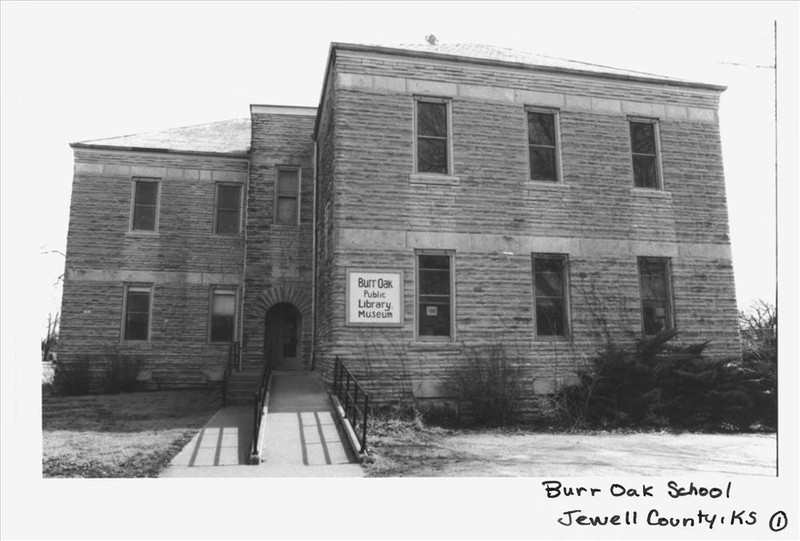Burr Oak School, later the Burr Oak Public Library and Museum
Introduction
Text-to-speech Audio
This limestone structure was constructed in 1899 and served as Burr Oak's third schoolhouse to solve overcrowding at the previous school following a near-unanimous vote from city residents. The new school was designed in Romanesque style by Topeka architect J.C. Holland and built by Jewell local J.W. Berry on land donated to the school district by town founder A.J. Godfrey. High school classes met here until 1916, and the building operated as a grade school until 1967. When both branches of the Burr Oak Schools had moved out, city residents pushed for the city to purchase the building in an effort to keep it from falling into disrepair or being torn down. Despite many challenges, including the need for repairs noted upon its addition to the National Historic Register in 2005, the community's efforts to maintain and repurpose the structure have led to its preservation and continued service to the community.
Images
Burr Oak School, Burr Oak, Jewell County, Kansas

Burr Oak School, Burr Oak, Jewell County, Kansas

Backstory and Context
Text-to-speech Audio
Burr Oak formerly had two school buildings. The first followed the Missouri Pacific Railroad's arrival in 1879 and subsequent boom in population. The second was filled to capacity by 1898, forcing some students to attend classes in the G.A.R. building across the street. Understandably, the residents of Burr Oak voted almost unanimously to build a new school, which they did on land that the town's founder, A.J. Godfrey, had donated to the school district.
The new schoolhouse, a Romanesque building, was designed by Topeka architect J.C. Holland and constructed by Jewell local J.W. Berry at a cost of $7000, equal to roughly 259 thousand dollars today. It was built out of limestone quarried from the Randall area, located about 30 miles north of here. The school finally opened its doors on January 2, 1900. From then, it served as both the area high school and grade school in 1916. The new high school was built then, leaving this school to only house grade school classes until 1967. The grounds also served as a community meeting place when classes were out of session in the summer months. Sometimes, the Chautauqua would pitch their tents nearby for performances, and locals would also hold baseball games and picnics on the school property.
When the school moved operations to a newer building in 1967, the residents of Burr Oak voted to allow the city to purchase the now-empty limestone school building. They hoped that the city's ownership would keep the structure from falling into disrepair or having to be torn down altogether. This has mainly been successful, with the building remaining in use as a library and museum. However, as of the structure's addition to the National Historic Register in 2005, it was in serious need of repair and preservation.
Cite This Entry
Rieber, Ellie and Clio Admin. "Burr Oak School, later the Burr Oak Public Library and Museum." Clio: Your Guide to History. November 13, 2023. Accessed April 22, 2025. https://theclio.com/entry/174426
Sources
Brown, Betty or McNichols, Betty. Burr Oak School - National Register of Historic Places Registration Form, National Parks Gallery. April 5th, 2005. Accessed November 12th, 2023. https://npgallery.nps.gov/GetAsset/c70148cb-ef52-46bf-9384-9af07c054043/.
Flickr
National Parks Gallery

